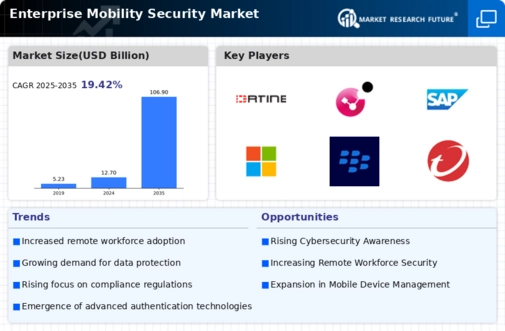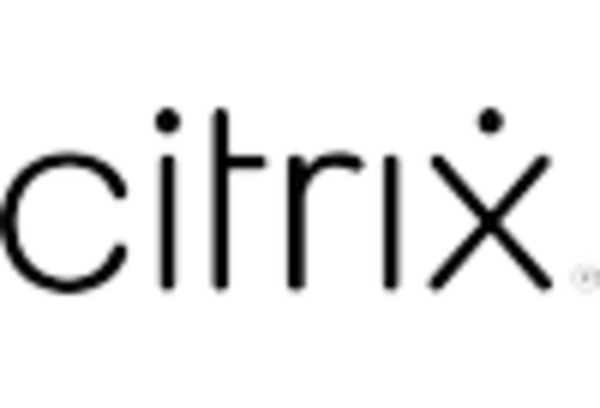Rise in Mobile Workforce
The increasing prevalence of remote work and mobile workforce dynamics has propelled the Enterprise Mobility Security Market. Organizations are increasingly adopting mobile devices to enhance productivity and flexibility. According to recent data, approximately 70 percent of employees are expected to work remotely at least once a week by 2025. This shift necessitates robust security measures to protect sensitive data accessed through mobile devices. As a result, enterprises are investing in comprehensive mobility security solutions to mitigate risks associated with data breaches and unauthorized access. The demand for secure mobile applications and device management solutions is likely to drive growth in the Enterprise Mobility Security Market.
Growing Cybersecurity Threats
The escalation of cybersecurity threats has emerged as a critical driver for the Enterprise Mobility Security Market. With the rise of sophisticated cyberattacks, organizations are compelled to fortify their mobile security frameworks. Data indicates that mobile devices are increasingly targeted, with a significant percentage of breaches originating from mobile platforms. This alarming trend has prompted enterprises to prioritize security investments, leading to a surge in demand for advanced security solutions. The need for threat detection, data encryption, and secure access controls is likely to shape the landscape of the Enterprise Mobility Security Market, as businesses seek to safeguard their digital assets.
Regulatory Compliance Requirements
The stringent regulatory landscape surrounding data protection and privacy is a key driver for the Enterprise Mobility Security Market. Organizations are mandated to comply with various regulations, such as GDPR and HIPAA, which necessitate the implementation of robust security measures for mobile devices. Failure to comply with these regulations can result in severe penalties and reputational damage. Consequently, enterprises are investing in mobility security solutions that ensure compliance while safeguarding sensitive data. The increasing focus on regulatory adherence is likely to propel the demand for comprehensive security frameworks within the Enterprise Mobility Security Market.
Increased Adoption of BYOD Policies
The growing trend of Bring Your Own Device (BYOD) policies is reshaping the Enterprise Mobility Security Market. Organizations are increasingly allowing employees to use personal devices for work purposes, which presents unique security challenges. This trend necessitates the implementation of effective security measures to protect corporate data accessed through personal devices. Data suggests that nearly 60 percent of organizations have adopted BYOD policies, highlighting the need for secure mobile access solutions. As businesses seek to balance employee flexibility with data security, the demand for mobility security solutions tailored to BYOD environments is likely to drive growth in the Enterprise Mobility Security Market.
Advancements in Security Technologies
Technological advancements in security solutions are significantly influencing the Enterprise Mobility Security Market. Innovations such as artificial intelligence, machine learning, and behavioral analytics are enhancing the capabilities of mobility security solutions. These technologies enable organizations to proactively identify and respond to potential threats, thereby reducing vulnerabilities associated with mobile devices. The integration of advanced security features into mobile applications is becoming increasingly common, as enterprises strive to protect sensitive information. As a result, the demand for cutting-edge security technologies is expected to drive growth in the Enterprise Mobility Security Market, fostering a more secure mobile environment.

















Leave a Comment